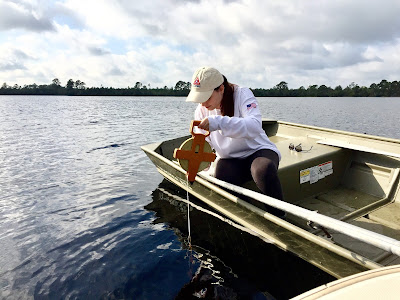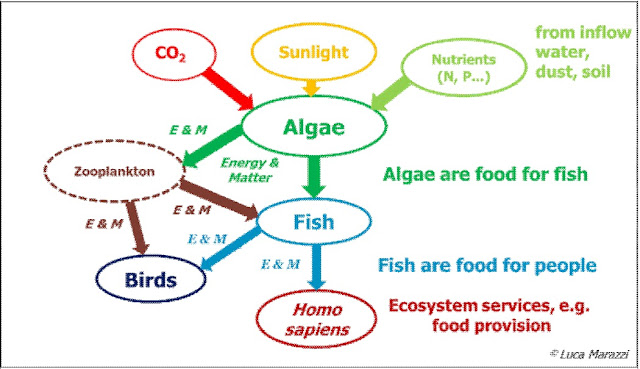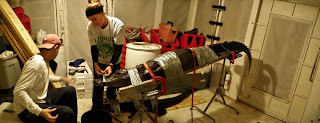Diatom of the Month: December 2016 - Tabellaria fenestrata
by Kristen Dominguez*
As
an undergraduate student in Evelyn Gaiser’s Lab at Florida International
University (FIU), I was
by rainfall and groundwater is home to a wide variety of
organisms, including many planktonic
examines global trends in lake ecosystems.
Fig. 1. Kristen taking Secchi depth measurements of water transparency at Lake Annie.
Fig. 2. Kristen Dominguez (left), Dr. Evelyn Gaiser
(middle) and Dr. Emily Nodine (right) collecting samples at Lake Annie.
In
monomictic lakes such as Lake Annie, little mixing takes place between the
warmer surface
waters and the deeper colder waters during the hotter months;
but, as fall and winter come, the
water on top gets cooler and thus mixes with
the cold water below. These temperature fluctuations
occur each year with some
variations between different lakes. Our key research questions are:
what species would be affected
by these changes in thermal structure, and how would water
column stability
affect phytoplankton diversity? For several months, I worked on a microscope to
identify and count the algae found in 72 samples from a period covering the transition from
winter mixing to summer stratification in Lake Annie.
The same work is being done by students at GLEON lakes all over the world! Now that I am
analyzing the data, I realize the significance of our work. We observed a strong positive
relationship between water column stability and the number of dominant species (comprising 95% of
the total biovolume). Among these was Tabellaria fenestrata, our new diatom of the month. This
diatom is adapted to oligotrophy in Florida (Whitmore 1989), neutral pH of 7, and lives either in the
plankton (Krammer and Lange-Bertalot 1991) or attached to vegetation or other hard substrates
(Koppen 1975). It can form long straight chains1. Other key features of the frustule of T.
fenestrata are illustrated in Fig. 3.
In
Lake Annie, various diatoms, including T.
fenestrata was more dominant in later dates after the
lake mixing events, and so they seem to prefer more
stratified conditions. Here climatic
oscillations
have led to marked changes in transparency and thus stratification
via heat budget variations; and
even small rainfall changes may lead to
significant consequences on the biota (Gaiser et al. 2009).
Diatom communities
changed due to acidification caused by atmospheric pollution during
industrialization,
and consequent recovery from around 1970, as well as hydrological, phosphorus
loading and alkalization (Quillen 2009). We are fine-tuning our hypotheses in
order to enhance our
understanding of the relationships between water column
stability and diatom abundance,
dominance, and diversity patterns in this
subtropical ecosystem.
* *Undergraduate
student in the Gaiser Lab at the FIU Southeast Environmental Research Center.
This post was written in collaboration with Dr. Evelyn Gaiser and Dr. Luca Marazzi.
References
1. DeColibus,
D. (2013). Tabellaria fenestrata. In Diatoms of the United States.
Retrieved December
2. Gaiser E.E., N.D.
Deyrup, R.W. Bachmann, L.E. Battoe, H.M. Swain. (2009). Effects of climate variability on
transparency and thermal structure in subtropical, monomictic Lake Annie,
Florida. Fundamental and Applied
Limnology
175: 217–230.
3. Koppen, J.D. (1975). A morphological and taxonomic
consideration of Tabellaria (Bacillariophyceae)
from the
northcentral United States.Journal
of Phycology 11: 236-244.
4. Krammer, K. and
Lange-Bertalot, H. (1991). Bacillariophyceae.
3. Teil: Centrales, Fragilariaceae,
Eunotiaceae. In Ettl, H., Gerloff, J., Heynig, H. &
Mollenhauer, D. (Eds.). Süsswasserflora von
Mitteleuropa. 2(3): 1-576. Gustav
Fisher Verlag, Stuttgart, Germany.
5. Quillen A.K. (2009)
Diatom-based Paleolimnological Reconstruction of Quaternary Environments in a
Florida Sinkhole Lake, PhD- Dissertation. Florida International University, Miami,
131 pp.
6. Whitmore, Thomas J. (1989). Florida diatom
assemblage as indicators of trophic assemblage and pH.
Limnology and Oceanography 34(5): 882-895. American Society of
Limnology and Oceanography, Inc.





Comments
Post a Comment